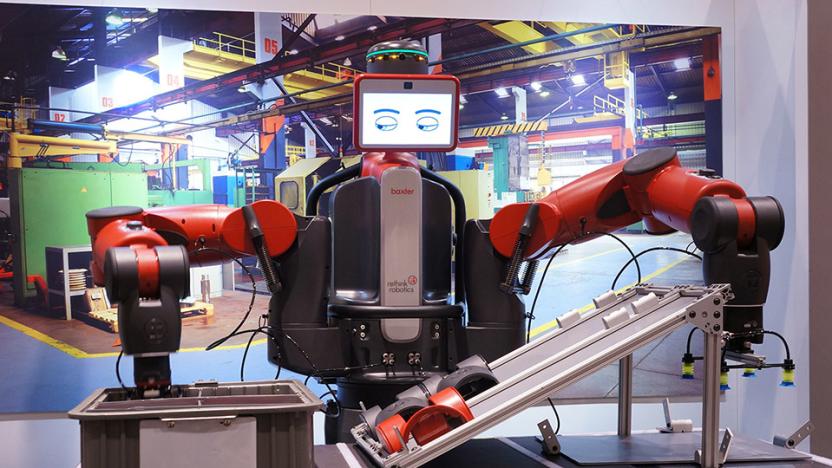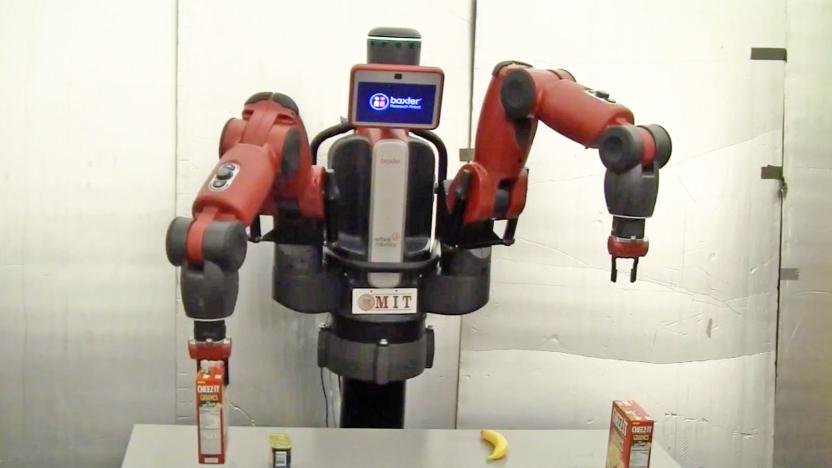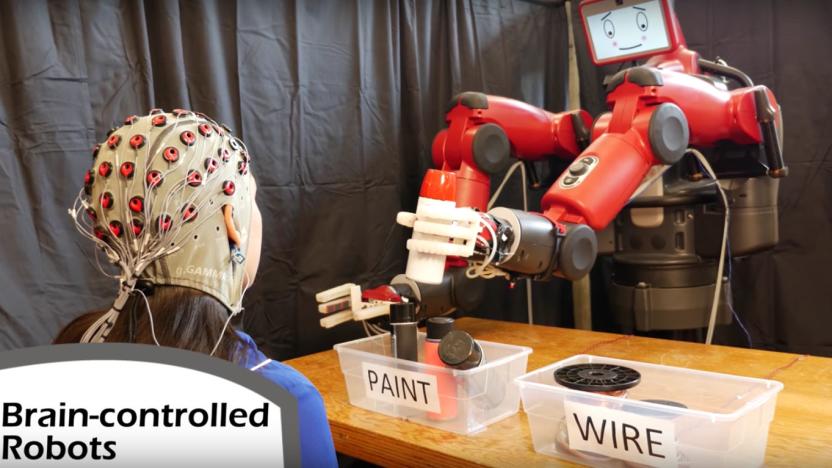baxter
Latest

Collaborative robot maker Rethink Robotics shuts down
For a while, it looked like Rethink Robotics would shake up the world with its collaborative robots: rather than having to write code, workers could teach bots to perform tasks by guiding them through the process. However, the market doesn't appear to have shared its vision. Rethink has suddenly shut down after a potential buyer backed out of a deal. Sales of Baxter and Sawyer robots weren't meeting expectations, Rethink chief Scott Eckert said, leaving the company low on cash. It really needed this acquisition to go through, in other words.

Robots learn to understand the context of what you say
It can be frustrating when telling robots what to do, especially if you aren't a programmer. Robots don't really understand context -- when you ask them to "pick it up," they don't usually know what "it" is. MIT's CSAIL team is fixing that. They've developed a system, ComText, that helps robots understand contextual commands. Effectively, researchers are teaching robots the concept of episodic memory, where they remember details about objects that include their position, type and who owns them. If you tell a robot "the box I'm putting down is my snack," it'll know to grab that box if you ask it to fetch your food.

MIT finds an easy way to control robots with your brain
A team from MIT's Computer Science and Artificial Intelligence Laboratory (CSAIL) wanted robots to be a more natural extension of our bodies. See, you'd usually have to issue vocal or very specific mental commands to control machines. But the method the CSAIL team developed works simply by reading your brain and detecting if you've noticed an error as the robot performs its tasks.

PhD student uses a robot to make VR feel more real
Between the HTC Vive and the Oculus Rift, we've come a long way towards being able to step in to virtual worlds -- but touching those false realities is a different matter. Solving this means finding a haptic technology that can adapt to needs of a constantly changing virtual environment. One PhD student's solution? Use a robot arm.

Robots learn to grasp objects by practicing and teaching each other
Even for robots, practice makes perfect. At least that's how it works for the technique developed by Brown University assistant professor Stefanie Tellex, which teaches robots how to pick up objects so they can relay the info to other robots. Tellex has been working on the technique with the help of an industrial machine called Baxter, which has two hands and a touchscreen face. These slightly human-shaped automatons use cameras and infrared sensors to examine an object -- they then pick it up from various angles using different grasps in order to find the most secure way to hold it. Once they do determine the perfect grip, the information is encoded in a format that can be shared online and uploaded onto other robots' brains.

Rethink delivers Baxter the friendly worker robot, prepares us for our future metal overlords (video)
No one would characterize existing factory robots as especially warm and fuzzy: they're usually disembodied limbs that are more likely to cut you than hug you. Rethink Robotics wants to put a friendly face on those machines, both figuratively and literally. Its about-to-ship Baxter worker robot carries a touchscreen face that's as much about communicating its intent as giving humans something more relatable. Likewise, it's designed to be easily programmed by its organic coworkers and react appropriately -- you guide Baxter by one of its two arms to tell it what to do, and its combination of cameras and a quad-core processor let it adapt to real-world imperfections. Even the series elastic actuators in its arms give it a softer, subtler movement that's less likely to damage products or people. While Baxter isn't as ruthlessly quick as most of its peers, the relatively low $22,000 price and promise of an SDK for its Linux brain in 2013 should make it easier to accept than the six-digit costs and closed platforms of alternatives. We just hope we're not being lulled into a false sense of security as lovable robots invade our manufacturing base ahead of the inevitable Robopocalypse. [Thanks to everyone who sent this in]

Columbine game blocked from receiving Slamdance special jury prize
When Slamdance festival director Peter Baxter removed Super Columbine Massacre RPG as a finalist in the festival's Guerrila Gamemaker Competition, he probably thought it would be the last time he would have to block the game from consideration for an award. As it so happened, though, Baxter found himself in a similar position last Friday night, when he reportedly stopped the game from receiving a special jury prize from the judges for the film documentary category. As detailed on Slamdance attendee Patrick Dugan's blog and confirmed by SCMRPG creator Danny Ledonne in an interview with Joystiq, the whole thing began on Tuesday, when Slamdance documentary juror Brian Flemming paused to watch an unofficial demo of the game put on by Ledonne on a laptop just outside the official game competition tent. Flemming, director of "The God Who Wasn't There," had heard about the controversy surrounding the game, and was intrigued enough by the demo to mention the game to his two fellow documentary jurors.


